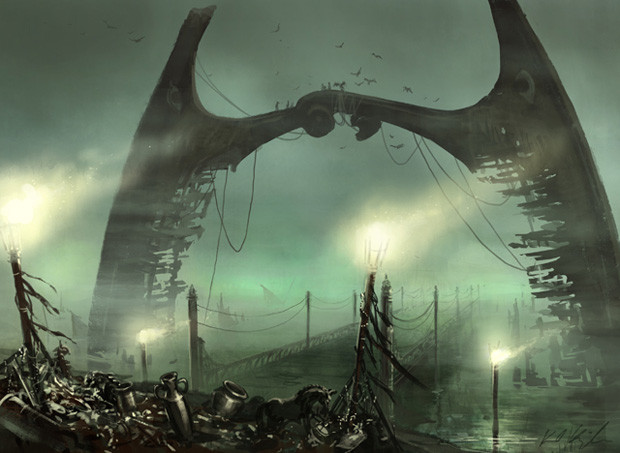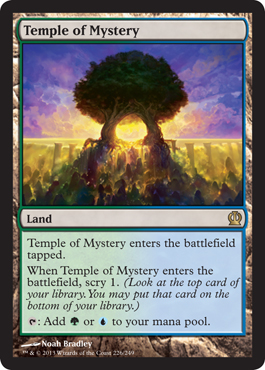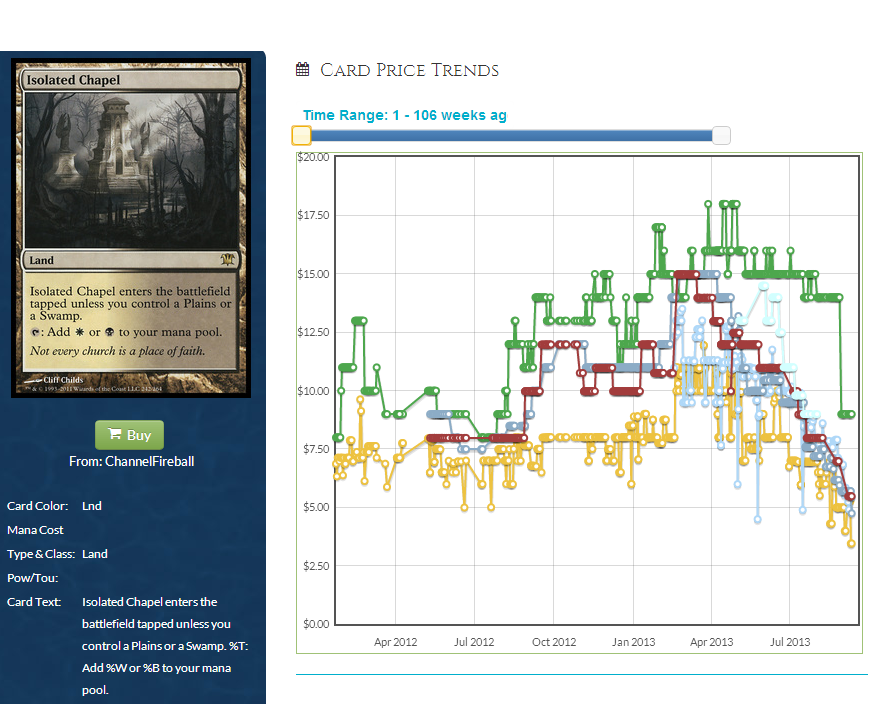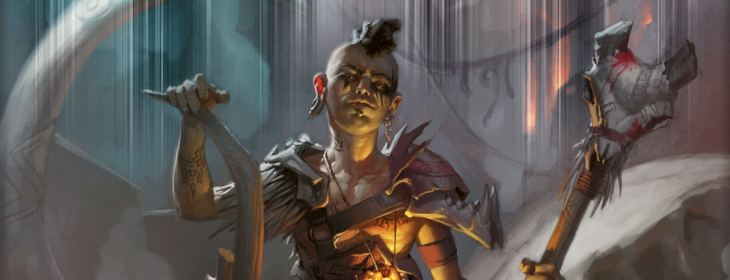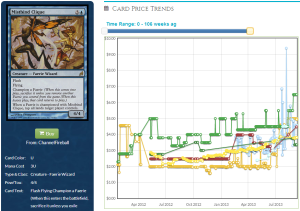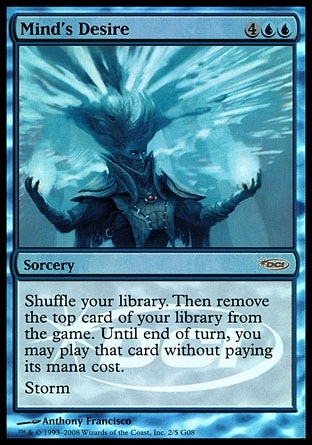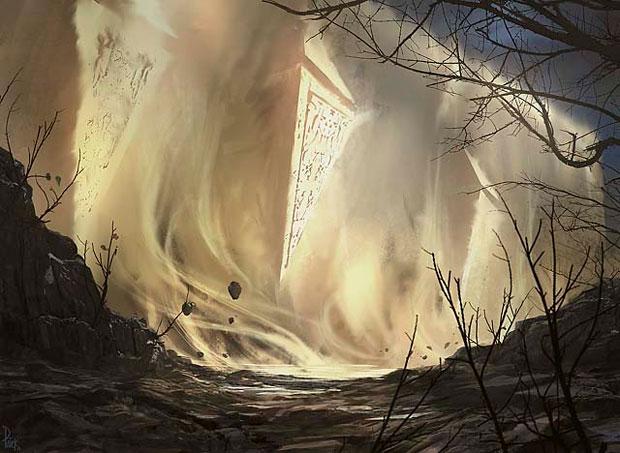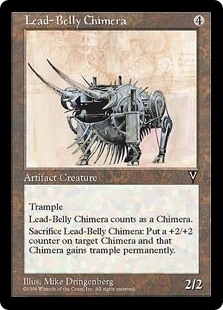This week I delve deeply into Theros and identify all target cards in the set that Standard players should look out for in the coming months. I have researched the entire set and have provided my commentary on what cards I believe will see Standard play or become more valuable in the future.
I have divided my analysis of each card into four categories. These categories indicate what I think are the best strategies to pursue when determining if you want to speculate on a card in Theros. They are:
-
ACTIVE PICKUP – About two weeks after the set’s release, the crazy preorder and release prices will die down. At that point, try to acquire more than just a playset. These cards have a lot of room to grow.
-
PASSIVE PICKUP – Pick these up if you feel you will need it for your Standard deck in the short term, but otherwise wait for event results to start rolling in before you invest in more than a playset.
-
HOLD OFF – Wait one-and-a-half to two months and then buy in at the target price. These cards may eventually see heavy play in Standard, but the price is too high to take the risk right now.
-
BULK BUY – These are the Sanguine Bonds and Darksteel Plates of Theros. If you are interested in more formats than Standard or are comfortable with long-term investments, these have strong potential. If you are only a Standard player however, I do not recommend Bulk Buy cards because it may take months or even years for the card to produce returns.
My analysis for each card I’ve identified in Theros is listed by color, lands, and artifacts. I have provided my reasoning for each pick to justify why I believe the target price to buy is a good opportunity versus buying in at the current price.
White
Chained to the Rocks
Because this is a cheap Swords to Plowshares that better resembles Journey to Nowhere, it can certainly be Standard playable. However, right now there are many other removal options that do not have a potentially devastating drawback (not having a Mountain as a mana source). Pass on this card for now. If it reaches bulk status, pick them up cheap in case it gets played later in it’s Standard life.
Current Price: $2
Target Price to Buy-In: $1
Final Verdict: HOLD OFF
Elspeth, Sun’s Champion
Elspeth is a popular Planeswalker, but this six mana incarnation is going to be a tough sell at $35. It might see Standard play in a control shell but never more than as a two of. Once she drops to $10 or less, then would be a good time to get in because Planeswalkers always have casual appeal. If you are a Standard only player though, avoid Elspeth for the time being unless you absolutely need it for a deck.
Current Price: $35
Target Price to Buy-In: $8-$10
Final Verdict: HOLD OFF
Fabled Hero
The new incarnation of Silverblade Paladin leaves a lot to be desired. Playing it in an aggro deck is wrong, because you will have to play less creatures in order to fit spells to target this guy… at which point you leave yourself wide open for a two-for-one. Pass on this card; it will reach bulk status. Then you can pickup a playset in case the day comes in which he is better.
Current Price: $1
Target Price to Buy-In: BULK to $1
Final Verdict: HOLD OFF
Heliod, God of the Sun
I could see Heliod being the centerpiece of a deck due to many good white weenie cards that can turn on devotion easily. Though I do not think he will maintain the release price of $10, once he drops to half or less it will be a good time to pick up a playset for future brews.
Current Price: $10
Target Price to Buy-In: $3-$4
Final Verdict: HOLD OFF
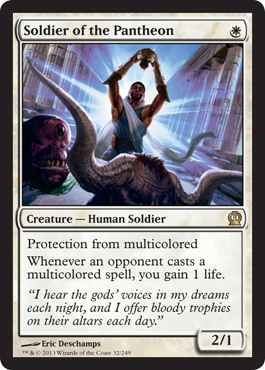
Soldier of the Pantheon
This is a great card that will see play in Standard, most likely alongside Heliod or even in other W/X aggro builds. Picking him up for $3.50 does not seem right to me, but once he goes down to $2 or even $1 I would definitely pick him up because he will see play at some point in Standard.
Current Price: $3.50
Target Price to Buy-In: $1-$2
Final Verdict: PASSIVE PICKUP
Spear of Heliod
A Glorious Anthem with an upside seems good at first glance, but realize that it takes a lot of mana to get going with this thing. For $2 I won’t be buying in, but for bulk status you cannot go wrong because the effect is powerful and just needs a synergistic deck to get working.
Current Price: $2
Target Price to Buy-In: BULK
Final Verdict: HOLD OFF
Blue
Bident of Thassa
Since this card is starting in bulk, it can really only go up from here if it sees even a smidgen of Standard play. I would not pick this up actively, maybe as a trade throw in, but grab at least a play set at bulk since you can’t really go wrong.
Current Price: BULK
Target Price to Buy-In: BULK
Final Verdict: BULK BUY
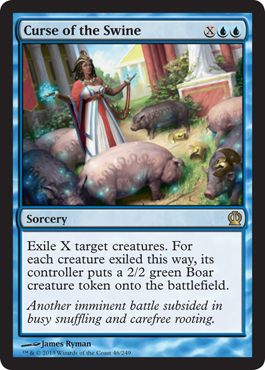
Curse of the Swine
Because of the flavor of this card, I never see it going below a dollar. Many people are trying to get the card just for its casual appeal, so buying at $1 you will not lose any money. However, it probably won’t see Standard play so do not buy for that purpose if you thinking of this card as a speculation target.
Current Price: $1
Target Price to Buy-In: $1
Final Verdict: PASSIVE PICKUP
Master of the Waves
Terrible in Standard, however this card will hold casual appeal once it rotates out. If you are a Standard player, stay far away, but if you play Standard as well as casual, buying in at $2 (which is bulk for mythic rares) seems like the right call for Master of Waves.
Current Price: $6
Target Price to Buy-In: $2
Final Verdict: BULK BUY
Swan Song
May be played in Standard, but I doubt it. Giving your opponent a Wind Drake seems bad in a format that is not combo based. Wait to buy in on this one because while Swan Song will likely be played in more combo-heavy formats (Modern, Legacy,) there is plenty of time for the price to drop first.
Current Price: $3.50
Target Price to Buy-In: $1-$2
Final Verdict: HOLD OFF
Thassa, God of the Sea
Thassa seems very overpriced to me at this point. Scrying for one every upkeep is useful, but not $16 useful. I recommend waiting until she submerges to a more reasonable $7-$8, because while she’s too expensive now, there’s certainly a chance she could find a home in Standard control decks.
Current Price: $16
Target Price to Buy-In: $7-$8
Final Verdict: HOLD OFF
Black
Agent of the Fates
Agent can be very effective if played in the right deck, but for now the support does not exist to make him strong enough. Don’t be afraid to buy in at bulk prices, but avoid picking up at retail.
Current Price:$2
Target Price to Buy-In: BULK
Final Verdict: HOLD OFF
Erebos, God of the Dead
Erebos is a great card that will have a deck built around him. However, like most cards in Theros, as more packs are opened the price of Erebos will decrease because he only fits into one or two archetypes. Wait to pickup.
Current Price: $11.50
Target Price to Buy-In: $5-$6
Final Verdict: HOLD OFF
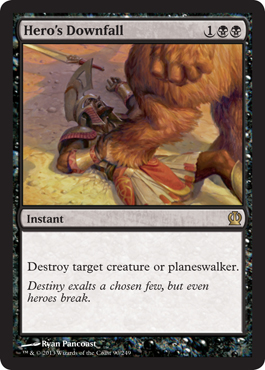
Hero’s Downfall
If I had to, I would still feel comfortable buying in at $4. This will be the premium removal at Rare moving forward. It is even better than Dreadbore and complements Doomblade nicely. It might see a price reduction to $2-$3 if black does not see a resurgence in play, though I doubt it since Thoughtseize is also coming back. Wait to see if it drops, but if there’s upward movement grab your play set before it gets expensive.
Current Price: $4
Target Price to Buy-In: $3-$4
Final Verdict: PASSIVE PICKUP
Thoughtseize
Thoughtseize is a definite staple in the new Standard, we can all agree on that. However, when is the correct time to buy? I usually find that waiting 1.5 to 2 months after a set’s release to be the optimum time to buy the more expensive format staples. They will be reasonably priced at this point and are guaranteed to go up in price as they get older in Standard. I predict Thoughtseize will go no lower than $15, so this is the sweet spot to pick this up. If you have to bite the bullet and buy now, go ahead but I highly recommend waiting if you can.
Current Price: $23
Target Price to Buy-In: $15-$17
Final Verdict: PASSIVE PICKUP
Red
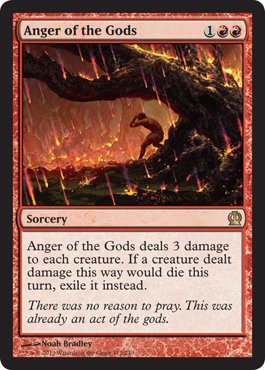
Anger of the Gods
I like this sweeper as a complement to Mizzium Mortars. What I don’t like is the RR casting cost, which unfortunately does not count toward Devotion. I also don’t see this taking the same path as Slagstorm, which was a staple in the Mono Red Standard deck when Mirrodin Besieged was Standard legal and commanded a price to match that (being $8-$10 at its peak). It also does not hit players and get that extra damage in like Slagstorm when you most need it. However, despite all its faults, there is potential which is why I recommend picking up a play set. At the very worst, this will see Modern play and still retain its $3 price tag. If it goes deeper, then profits can certainly be made.
Current Price: $3
Target Price to Buy-In: $2
Final Verdict: ACTIVE PICKUP
Hammer of the Purphoros
I like the Hammer because it makes your deck faster and your Devotion better. Unfortunately, 3 mana is one mana too much for this card. I foresee it hitting bulk pretty soon, which will be a good time to pick them up. Even though it will hit bulk, it could definitely go up a lot if it is one the key synergies in a future Standard deck.
Current Price: $1.30
Target Price to Buy-In: BULK
Final Verdict: HOLD OFF
Magma Jet
This is a great uncommon that will see play in Standard throughout its entire life in the format. Pick these up now and trade for them at every opportunity; they will always hold value.
Current Price: $.95
Target Price to Buy-In: $.95
Final Verdict: ACTIVE PICKUP
Purphoros, God of the Forge
Purphoros is in my opinion the strongest god in the set. His mini-Pandemonium ability is fantastic and gives value to all of your one and two drops after turn four, making your draws that much better later in the game. However, I see him as a wax-and-wane type card that will fall in and out of favor as aggro and control battle for the top spot in Standard. In the lulls, when Purphoros goes down pick them up for $14-$16 and you will not be disappointed. He will go up again because his impact is that strong.
Current Price: $22
Target Price to Buy-In: $14-$16
Final Verdict: PASSIVE PICKUP
Stormbreath Dragon
See Thundermaw Hellkite. This card will drop to about half of it’s preorder price, and then afterwards the sky is the limit. Well, not really – there is one big difference between the two, and that is the Hellkite was in a core set. Core sets aren’t opened nearly as much as the fall set, so $20 is probably the max for this card if it sees any significant amount of Standard play. Try to get in at the low point two months from now and then see gains as it goes up throughout his Standard life unless you have to buy them to complete your Standard deck.
Current Price: $25
Target Price to Buy-In: $8-$10
Final Verdict: PASSIVE PICKUP
Green
Arbor Colossus
Did you know this card is only 5 mana for a 6/6 with reach, and then an UPSIDE? Hard to believe that a card like this can be outclassed in Standard, but there you have it. The power of creatures has certainly risen significantly over the years. I do see how this might see Standard play since you can play him as a 6/6 by turn four with acceleration, and then make him a 9/9 by turn five that may also bring down an opposing flier. There are a lot of small upsides to this card that in the big picture could add up to great value. I wouldn’t actively pick these up, but I could see them increasing down the road if someone plays the card as “tech”. Even if it doesn’t hit, just out them for bulk and get your money back.
Current Price: BULK
Target Price to Buy-In: BULK
Final Verdict: HOLD OFF
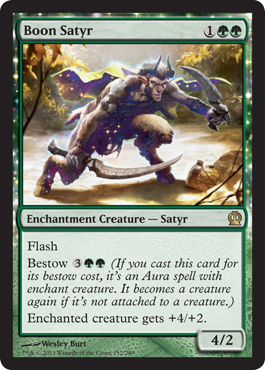
Boon Satyr
Boon Satyr is an interesting card. It reminds me of Wolfir Avenger, which saw Standard play. However this guy is a rare, so has the chance of reaching much higher prices than Wolfir Avenger did. I can see him being played and if the deck puts up results you can expect Boon Satyr to increase in price accordingly.
Current Price: $2
Target Price to Buy-In: $1-$2
Final Verdict: ACTIVE PICKUP
Bow of Nylea
Similar to Arbor Colossus, this card has an insane amount of abilities for a decent mana cost. I think that this card could definitely see Standard play, but paying more than $2 for the bow at this point seems a bit much. Pick them up for $2 or less in a month or so. Remember the bow is in a preconstructed deck.
Current Price: $2.50
Target Price to Buy-In: $1-$2
Final Verdict: BULK BUY
Mistcutter Hydra
Green really is getting all the crazy cards with multiple abilities this set. Here is another card with all sorts of things going on that has the potential to see play. Without trample, I like Mistcutter Hydra a little less than Arbor Colossus or Bow of Nylea. Hydras are a popular casual card, so if you pick up this up at bulk it could be a good investment some ways down the road. If you are only a Standard player though, I would avoid this card as a speculation target.
Current Price: $3
Target Price to Buy-In: BULK to $2
Final Verdict: HOLD OFF
Nemesis of Mortals
This uncommon is very powerful. It is a mini-Ghoultree that takes two turns to make big, but comes out initially at a decent mana cost. It could see Standard play at some point, so I would actively try to get a play set. After that point pick them up in trades whenever you can.
Current Price: $.10
Target Price to Buy-In: $.10
Final Verdict: ACTIVE PICKUP
Nylea, God of the Hunt
The green god feels like it will have the least impact on Standard, since her abilities are somewhat tame compared to the other gods. However, it will be a big hit with the casual crowd, so picking them up at $4 in a few months is a solid play.
Current Price: $9
Target Price to Buy-In: $4-$5
Final Verdict: HOLD OFF
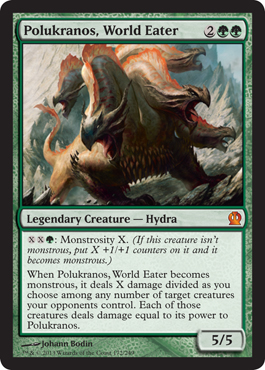
Polukranos, World Eater
This is the mythic hydra of the set, and it does a good job of filling that role. It is already being brewed into the next version of Jund for standard, so I would actively try to pick them up if you are looking to build midrange Jund. At the least, it will be popular casual card that will keep from being a dollar bin mythic. Paying $4 for these is completely acceptable if you need them for Standard.
Current Price: $4
Target Price to Buy-In: $2-$3
Final Verdict: ACTIVE PICKUP
Sylvan Caryatid:
After Elvish Mystic, this is the next best mana ramp. Expect to see a ton of this card in Standard over the next several months as every three color green deck needs to play four of these in order to maintain mana base consistency. If you are planning on playing three colors in the new Standard, get your play set ASAP.
Current Price: $5
Target Price to Buy-In: $2-$3
Final Verdict: ACTIVE PICKUP
Multicolor
Anax and Cymede
Anax and Cymede could be good in an aggro build that supports the ability, but unfortunately not as more than two or three copies. Because they are legendary, EDH fans will like the card, so it will never be exactly bulk. The duel deck will also keep the price down, so I wouldn’t be actively trying to pick these up even though it will probably see Standard play.
Current Price: $1
Target Price to Buy-In: BULK to $1
Final Verdict: HOLD OFF
Chronicler of Heroes:
Another really great uncommon from the set. Whoever heard of G/W creatures drawing cards when they come into play? Unfortunately, it needs a specific strategy built around it in order to be good, so it could turn out to be a dud. Getting them at bulk uncommon prices though ($0.05) seems good because the potential is there.
Current Price: $.2
Target Price to Buy-In: BULK
Final Verdict: HOLD OFF
Daxos of Meletis
Might see play in Standard; the ability is really great in control mirror matches. However, he is not very useful against most decks and will probably end up as bulk. Try and pick up foils of this card, though, as he will be an amazing commander in EDH. Avoid as a spec target if you are only a Standard player.
Current Price: $2
Target Price to Buy-In: BULK to $1
Final Verdict: HOLD OFF
Fleecemane Lion
This card is deceptive. Yes, I remember how good Watchwolf was back in the day, but these days Watchwolf is simply outclassed. The monstrous upgrade is simply too much mana at five to come online at any important stage of the game. I foresee these quickly dropping as people realize the cat isn’t as good as it seems at first glance. That said, Fleemane Lion will definitely be a casual crowd favorite for years to come, so wait for the opportunity to buy in at low prices.
Current Price: $8
Target Price to Buy-In: $2-$3
Final Verdict: HOLD OFF
Polis Crusher
I could see Polis Crusher as a good sideboard card against certain archetypes, but honestly he is a worse Ghor-Clan Rampager. Pick up at bulk in case it comes online as good tech against certain match-ups but otherwise avoid.
Current Price: $.75
Target Price to Buy-In: BULK
Final Verdict: HOLD OFF
Reaper of the Wilds
Another card that seems really great at first glance but I believe will ultimately turn out to be underwhelming. Sure, being able to Scry 1 for every creature that dies can be pretty powerful, but doesn’t actually get you there. Deathtouch isn’t important on a 4/5, but on-demand hexproof makes this gal unexpectedly resilient. Definitely pick them up at bulk in a few months because Reaper could see Standard play eventually.
Current Price: $2
Target Price to Buy-In: BULK to $1
Final Verdict: HOLD OFF
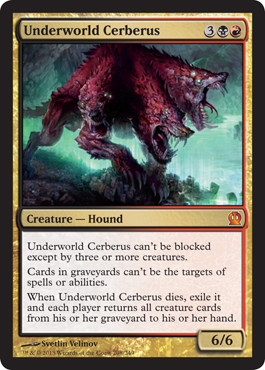
Underworld Cerberus
This card is interesting. I want to believe Cerberus will follow the same trajectory as Master of Cruelties, but this guy is a 6/6 that will probably be unblockable most of the game in B/R, which are colors that do not see that ability very often. It also will be quite good in midrange Jund because it is pretty much unkillable outside of sweepers like Supreme Verdict. No wrath effects in Theros have everyone scratching their heads but it only makes cards like this even more insane. My strategy is to see how this plays out in the first few months in Standard. If you plan on playing it, pick up your play set now for $20 because it will most likely be a good deal in the long run. If you want to speculate on this card, wait for the results to come in before you decide. If it doesn’t put up amazing results, wait until it hits $2-$3 and then pick them up.
Current Price: $5
Target Price to Buy-In: $2-$3
Final Verdict: PASSIVE PICKUP
Xenagos, the Reveler
I anticipate Xenagos being played in Standard, but I see him taking the same path as Garruk Relentless. Starting out high at $20, slowly dropping to the mid teens and then eventually petering out at $7-$8. Wait until more Theros packs are opened if you want to play him in Standard; $15 will be comfortable to buy in at if you want to play Xenagos in Standard. If you are purely speculating, wait until January and then Xenagos will be much more affordable.
Current Price: $25
Target Price to Buy-In: $8-$10
Final Verdict: PASSIVE PICKUP
Lands/Artifacts
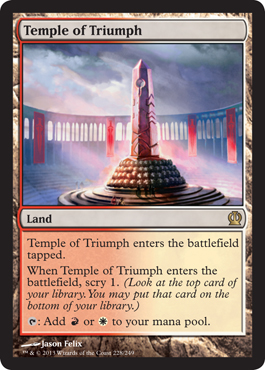
The Scrylands
My prediction for all of the Scrylands is that people will be underwhelmed with them (as they should, really the lands should be uncommons,) but as time goes on in Standard all premium real estate will go up in value. Rare or higher lands (real estate as I refer to them) for the most part are the safest investment in Standard (and also other formats) because Standard players know that eventually they will have to play them, if not this year than certainly the year after that. They may go down to a measly $1-$2 in the beginning, but remember when Seachrome Coast was $20? Darkslick Shores $25? I certainly do, and it is a good lesson to learn – get your rare, dual colored lands early or pay the price later. Or in this case, make profits later. If you need any of these lands, picking them up for $4 now and getting your play set will still be fine in the long run. If you can wait, or if you want extras to trade later, pick up the scry lands when they bottom out around $1-$2 and hold onto them until they ultimately rise.
Current Price: $4
Target Price to Buy-In: $1-$2
Final Verdict: ACTIVE PICKUP
Colossus of Akros
The Colossus is the last card I want to mention. Even though this card seems like a complete dud, and most likely won’t see Standard play, don’t be so quick to get rid of yours. Huge fat fatties seem to have a thing for increasing exponentially in price over time. Remember It That Betrays? I didn’t either, until I saw that it is $7.50 at most stores online… and that card never saw a lick of Standard play. It That Betrays’ price completely hinges on casual players, and I think Colossus of Akros will follow the same path, as it is a very Timmy card that appeals to casuals and EDH players. Don’t actively pick these up, but rather get them as trade throw-ins or at bulk prices because eventually (maybe years down the road) I see these guys rising to an absurd price for a generally bad card.
Current Price: $.50
Target Price to Buy-In: BULK
Final Verdict: BULK BUY
Conclusion
As you can see, most of the cards will drop in price and I recommend waiting to pick them up at their lower prices unless you absolutely need them for a Standard deck. If you feel that any of the cards I have evaluated should be reassessed I encourage you to leave a comment and explain your reasoning. In addition, if you feel that I have missed any important cards for the upcoming Standard environment you should likewise feel free to comment and let me know.
